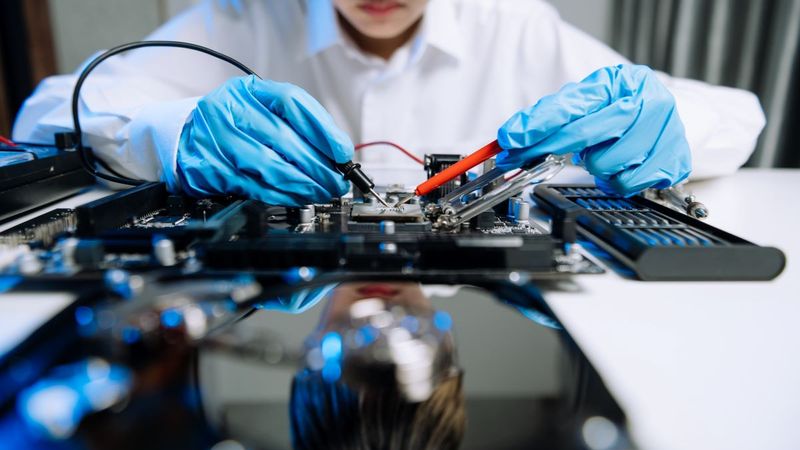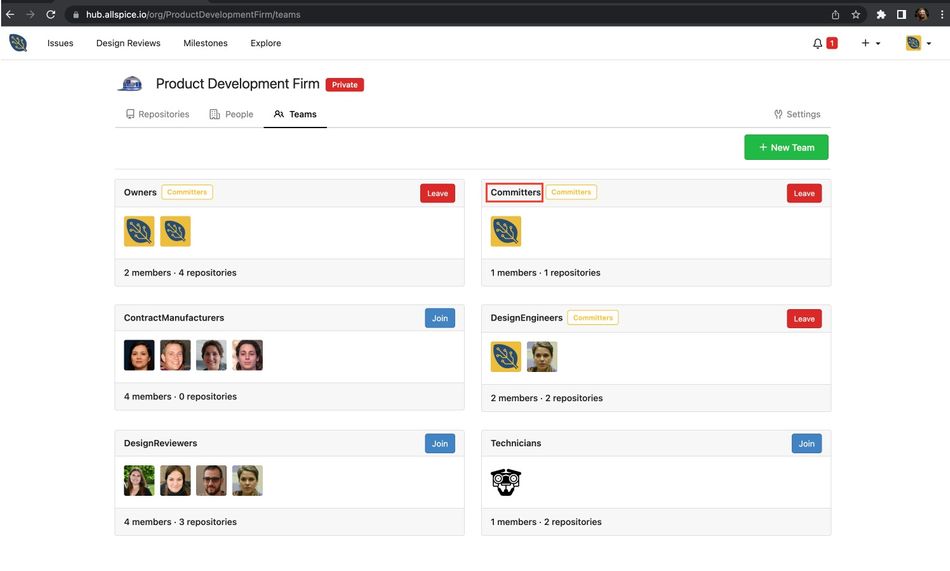Scaling Hardware Design with Git: Strategies for Large Team Management
Using Git enhances the scalability of hardware development by providing robust version control and seamless integration with design and project management tools, supporting efficient collaboration across increasingly large and complex teams.
Introduction
In the continuously evolving field of hardware development, Git has emerged as a critical tool for managing complex design workflows and enhancing collaboration across multidisciplinary teams. Through its robust version control capabilities, Git enables precision, efficiency, and scalability—qualities essential for today’s high-stakes engineering projects. Our series The Future of Hardware Development has explored how Allspice.io, a Git-based platform tailored for hardware projects, can revolutionize traditional hardware development processes.
This article shifts focus towards the specific challenges associated with scaling hardware projects. We talk about some of the advanced strategies for managing large-scale operations and teams, providing insights into leveraging Git’s full potential to maintain project integrity and streamline team dynamics in expansive hardware development environments.
This article is part of The Future of Hardware Development, a series featuring insights into how cutting-edge collaborative platforms transform traditional hardware development workflows, integrating advanced version control systems and paving the way for more efficient, error-free project management.
Explore other articles from this series:
- The Future of Hardware Development: Collaborative tools and techniques
- Learning from Git: The Role of Software Practices in Hardware Development
- Implementing Git for Hardware in 30 Days: Insights from the E-Book by AllSpice
- Scaling Hardware Projects with Git: Strategies for Large Team Management
- Silos to Synergy: Encouraging Cross-Disciplinary Teamwork in Hardware Development Teams
Challenges in Large Team Hardware Development
Managing large hardware projects involves coordinating diverse teams and numerous moving parts, introducing several challenges impacting efficiency and success. As more individuals join a project, the complexity of communication and coordination escalates. Each team member might have different tasks, goals, and responsibilities, leading to potential misalignment without clear and effective communication channels.
Additionally, as hardware projects scale, the likelihood of version conflicts increases. Multiple engineers working on the same design files or components can simultaneously lead to conflicts that stall progress and require time-consuming resolutions. The sheer size of operations in these projects can be daunting—managing extensive documentation, numerous design revisions, and various integration points across hardware and software components necessitates a robust framework to ensure consistency and traceability throughout the project lifecycle.
Large projects often utilize a variety of tools and platforms, complicating integration and data consistency. Ensuring that all tools communicate effectively and that data is synchronized across platforms is essential but challenging.
Moreover, traditional project management frameworks may not be fully equipped to handle the dynamic and iterative nature of large hardware development projects. Adapting principles such as agile methodologies or similar approaches often becomes necessary to manage the continuous integration of changes and updates effectively.
Git’s Role in Enhancing Team Collaboration
Git, widely recognized for its robust version control capabilities in software engineering, is equally vital in managing large hardware projects. Its features significantly enhance collaboration across multidisciplinary teams by streamlining complex project workflows. Here are some of the features of Git that facilitate improved teamwork:
Centralized Repository: Git provides a centralized platform where all project files are stored. This serves as a single source of truth for the project, ensuring that all team members access the most current files and reducing the risks of inconsistencies.
Efficient Branching Strategies: Git allows teams to work on independent tasks simultaneously by utilizing branching. This feature lets developers create separate branches for individual features or bug fixes, which can later be merged back into the main project line without disrupting ongoing work.
Change Tracking: Every modification made by team members is tracked by Git, providing a clear audit trail of who did what and when. This transparency is critical for accountability and helps in tracing the origin of issues when they arise.
Conflict Resolution: Git has built-in tools to detect and resolve conflicts that may occur when merging branches. This helps in maintaining the integrity of the project and reduces downtime that could be caused by manual conflict resolution.
Design Reviews: Pull requests in Git not only allow team members to propose changes to the hardware designs but also facilitate peer reviews. This process ensures that all changes are vetted before integration, improving the quality of the project and fostering a culture of collaboration.
Continuous Integration and Continuous Deployment (CI/CD) Integration: CI/CD are easily integrated with Git, automating the testing and deployment processes. This automation helps in maintaining a high standard of quality and efficiency as the project scales.
Clear & Shared Documentation: Git supports the inclusion of extensive documentation alongside schematics, which is crucial for complex projects. Well-documented projects help new team members get up to speed quickly and aid in the maintenance and scalability of the project.
Access Control and Permissions: Git allows the implementation of role-based access control, ensuring that sensitive areas of the hardware design are only accessible to authorized personnel. This feature is particularly important in large teams where managing access is critical to security and compliance.
AllSpice enhances Git's role-based access control by limiting access to specific parts of hardware designs to authorized team members only.- Monitoring and Analytics: Tools integrated with Git can provide valuable analytics on project contributions, health, and progress. These insights help managers make informed decisions about resource allocation and project timelines.
Scaling with Git: Best Practices
Scaling hardware projects efficiently requires more than just implementing Git; it necessitates a series of best practices that ensure smooth operations and high productivity. Here’s a look at some best practices for large teams:
Efficient Branching Strategies:
Git Flow or Trunk-Based Development: Choose a branching strategy that suits the scale and style of your project. Git Flow is ideal for projects with scheduled releases, while trunk-based development suits continuous delivery environments.
Feature Branches: Utilize feature branches to keep ongoing developments separate from the main production branch, merging them only after thorough testing and review.
Design Reviews and Merge Protocols:
Pull Requests: Use pull requests as a standard practice for reviewing designs before they merge into the main branch, ensuring quality and reducing bugs.
Mandatory Design Review Process: Implement mandatory design reviews for certain critical parts of the project, involving at least two peers to ensure oversight and quality assurance.
Automated CI/CD Pipelines:
Continuous Integration: Set up CI to automatically validate all changes as soon as they are committed to a repository, catching issues early in the development cycle.
Continuous Deployment: Use CD to streamline the deployment process, ensuring that new versions are smoothly transitioned into production with minimal downtime.
Commit Hygiene:
Small, Frequent Commits: Encourage hardware engineers to make smaller, more frequent commits, which simplify understanding changes and tracking issues.
Clear Commit Messages: Enforce a policy of clear, descriptive commit messages that explain the why and the what of the changes, providing context for other team members.
Scaling Repositories:
Mono-repos vs. Multi-repos: Decide between using a monolithic repository for all project assets or multiple smaller repositories based on project size and team structure. Each has its benefits; mono-repos simplify dependency management, while multi-repos can reduce build times.
Access Control and Permissions:
Role-Based Access Control: Implement role-based access to sensitive parts of the repository to prevent unauthorized access and accidental changes to critical assets.
Collaborative Tools Integration:
Automation Tools: Leverage tools like AllSpice Actions to automate routine tasks and maintain efficiency, integrating these tools directly with Git workflows.
Monitoring and Analytics:
Usage of Analytics Tools: Implement tools that provide insights into project health, developer productivity, and project progress to continually assess and adapt strategies.
By adhering to these best practices, teams can leverage Git more effectively and ensure that the scaling of hardware projects remains manageable, efficient, and aligned with the overall project goals.
Training and Adoption Strategies
Successfully integrating Git into a large hardware project team involves thoughtful preparation and customized training approaches to meet diverse needs. The first step is assessing the current Git knowledge within the team, which helps in tailoring the training sessions to fill gaps and reinforce existing skills. Developing training programs that cater to various levels of expertise is crucial, ranging from introductory sessions for beginners to advanced topics for seasoned users. Ensuring that every team member is comfortable and proficient with Git is essential for fostering an inclusive learning environment.
Hands-on training sessions are particularly effective as they allow team members to practice Git commands and workflows in real-world scenarios. These practical experiences are vital in simulating common project challenges where Git can be utilized to resolve issues, manage merges, and handle complex workflows. Encouraging the team to use Git in their daily tasks can solidify learning, enhance retention, and increase comfort with the tool.
It is also beneficial to provide comprehensive resources such as online tutorials, in-house wikis, cheat sheets, and regular tips and tricks sessions. Establishing a mentorship program can further aid the adoption process, pairing less experienced members with Git experts for ongoing support and guidance.
Finally, monitoring the adoption of Git using specific metrics and providing support where needed ensures that no team member is left behind.
Looking Forward: The Future of Git in Hardware Development
As we look to the future, the integration of Git into hardware development is set to deepen, driven by advancements in technology and the increasing demands of modern engineering projects. Emerging trends in automation and AI predict a future where Git not only streamlines workflows but also predicts and resolves conflicts before they disrupt development, enhancing efficiency and reducing downtime.
The evolution of Git is also likely to focus on improving collaboration tools within its ecosystem. Expect to see more sophisticated real-time editing capabilities, enhanced security features, and better conflict resolution tools that make managing large, distributed teams more seamless. As hardware projects grow in complexity, the scalability of Git will be critical, with enhancements anticipated in handling large files and high transaction volumes effectively.
Furthermore, as the adoption of Agile and DevOps practices becomes more widespread in hardware development, Git’s role will expand to support these methodologies more robustly. This will involve more integrated CI/CD pipelines and automated testing frameworks that align closely with hardware development cycles.
Ultimately, Git is all set to become more than just a tool but a foundational component that supports the dynamic, interconnected workflows of future hardware development projects.
Optimizing Large Scale Hardware Projects with AllSpice
AllSpice is transforming hardware development by leveraging Git's strengths and extending them to meet the specific needs of hardware engineers. As projects increase in complexity and scale, AllSpice offers an integrated platform that enhances collaboration, streamlines workflows, and ensures project consistency across large teams. It offers:
Centralized Platform for Enhanced Collaboration: AllSpice centralizes hardware design management facilitating easier access to the latest project updates, ensuring that all team members are aligned and reducing the risk of errors stemming from outdated information.
Seamless Integration with Design and Project Management Tools: AllSpice integrates with a wide range of ECAD tools like Altium Designer, KiCAD, and OrCAD, as well as project management software such as Jira and Slack. This integration ensures that changes in design files are reflected across all platforms, enhancing communication and collaboration. Engineers can see real-time updates in their preferred tools without the need to switch contexts, which boosts productivity and focuses on development.
Automated Workflows to Increase Efficiency: By automating routine tasks such as design checks and version updates, AllSpice significantly reduces manual overhead. Automated workflows ensure that designs pass all necessary checks before moving forward, which improves the quality of outputs and speeds up the development cycle. This automation is beneficial in large projects where the volume of tasks can be overwhelming and prone to human error.
Real-Time Design Reviews and Feedback: Traditional design reviews, once constrained to synchronous meetings with time-bound presentations, are being revolutionized by AllSpice. Real-time design reviews allow for asynchronous feedback, enabling reviewers to examine designs independently and at their own pace, enhancing the thoroughness and quality of reviews. By moving away from single-session critiques to flexible, continuous interaction, every aspect of a design receives expert attention without the limitations of scheduling conflicts or sequential input, significantly reducing oversight and accelerating the refinement process.
Advanced Analytics for Better Decision Making: With AllSpice, teams can utilize detailed analytics to monitor project progress and team performance. These analytics help identify bottlenecks, blockers, track contributions, and assess the health of the project, enabling managers to make informed decisions and allocate resources more effectively.
Enhancing Security with Role-Based Access Control: To protect sensitive project information, AllSpice implements robust access controls, ensuring that only authorized personnel can view or modify critical project components. This security feature is crucial for maintaining the integrity and confidentiality of large-scale projects.
By integrating these capabilities, AllSpice optimizes the use of Git in hardware development and pushes the boundaries of what teams can achieve in terms of efficiency, collaboration, and project management. As hardware projects continue to grow in size and complexity, AllSpice provides the necessary tools to manage these challenges effectively, ensuring that innovation remains at the front line of development efforts.
Conclusion
In this article, we've taken a close look at how AllSpice, a platform that brings features of Git to hardware engineering, optimizes the management of large-scale hardware projects. Using Git principles for hardware enhances collaboration, streamlines workflows and ensures scalability and security as project demands grow. The integration of Git with AllSpice brings a cohesive platform that simplifies complex processes and allows teams to focus on innovation rather than administrative overhead. As hardware projects continue to evolve, the continued adaptation and enhancement of these tools will play a crucial role in driving efficiency and success in hardware development.





